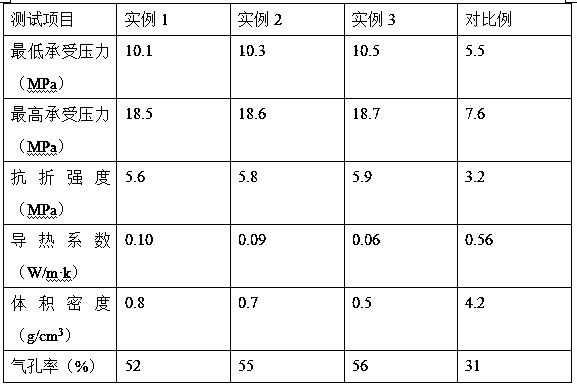Method for preparing high-strength light insulating brick
A thermal insulation brick, high-strength technology, used in ceramic products, applications, household appliances, etc., can solve the problems of not meeting market requirements, increasing the weight of the brick body, poor thermal insulation, etc. The effect of layer spacing
- Summary
- Abstract
- Description
- Claims
- Application Information
AI Technical Summary
Problems solved by technology
Method used
Image
Examples
example 1
[0023] Weigh 55g of aluminate cement and grind it for 10min, collect the ground powder, mix and stir the ground powder, acetone and phenol for 8min according to the mass ratio of 1:3:5, to obtain a stirring slurry, mix the silane coupling agent KH-560 and the stirring slurry Mix and stir for 10 minutes at a volume ratio of 1:5, place in an oven after mixing, and dry at a temperature of 85°C for 16 minutes, collect the dry matter and grind it through a 100-mesh sieve to obtain modified aluminate cement particles; by weight In terms of parts, weigh 7 parts of terephthalic acid, 1 part of antimony oxide, 8 parts of ethylene glycol and 21 parts of phosphoric acid, mix them in a beaker, and stir and react for 2 hours at a temperature of 200 ° C to obtain polyterephthalate Ethylene glycol formate, mix polyethylene terephthalate and 2 parts of quartz sand powder in a beaker, stir at 240°C for 35 minutes to obtain a modified polyester film melt; weigh 32g of kaolin Put it into a muffl...
example 2
[0025] Weigh 60g of aluminate cement and grind it for 11 minutes, collect the ground powder, mix and stir the ground powder, acetone and phenol for 9 minutes according to the mass ratio of 1:3:5, to obtain a stirring slurry, mix the silane coupling agent KH-560 and the stirring slurry Mix and stir for 11 minutes at a volume ratio of 1:5, place in an oven after mixing, and dry at a temperature of 87°C for 18 minutes, collect the dried material and grind it through a 100-mesh sieve to obtain modified aluminate cement particles; by weight In terms of parts, weigh 8 parts of terephthalic acid, 2 parts of antimony oxide, 9 parts of ethylene glycol and 3 parts of phosphoric acid, mix them in a beaker, and stir and react for 3 hours at a temperature of 220 ° C to obtain polyterephthalic For ethylene glycol formate, mix polyethylene terephthalate and 3 parts of quartz sand powder in a beaker, stir at 250°C for 40 minutes to obtain a modified polyester film melt; weigh 34g of kaolin Put ...
example 3
[0027] Weigh 65g of aluminate cement and grind it for 12 minutes, collect the ground powder, mix and stir the ground powder, acetone and phenol for 10 minutes according to the mass ratio of 1:3:5, to obtain a stirring slurry, mix the silane coupling agent KH-560 and the stirring slurry Mix and stir for 12 minutes at a volume ratio of 1:5, place in an oven after mixing, and dry at a temperature of 90°C for 20 minutes, collect the dry matter and grind it through a 100-mesh sieve to obtain modified aluminate cement particles; by weight In terms of parts, weigh 9 parts of terephthalic acid, 3 parts of antimony oxide, 10 parts of ethylene glycol, and 4 parts of phosphoric acid, mix them in a beaker, and stir and react for 4 hours at a temperature of 240 ° C to obtain polyterephthalate Ethylene glycol formate, mix polyethylene terephthalate and 4 parts of quartz sand powder in a beaker, stir at 260°C for 45 minutes to obtain a modified polyester film melt; weigh 36g of kaolin Put it...
PUM
 Login to View More
Login to View More Abstract
Description
Claims
Application Information
 Login to View More
Login to View More - R&D
- Intellectual Property
- Life Sciences
- Materials
- Tech Scout
- Unparalleled Data Quality
- Higher Quality Content
- 60% Fewer Hallucinations
Browse by: Latest US Patents, China's latest patents, Technical Efficacy Thesaurus, Application Domain, Technology Topic, Popular Technical Reports.
© 2025 PatSnap. All rights reserved.Legal|Privacy policy|Modern Slavery Act Transparency Statement|Sitemap|About US| Contact US: help@patsnap.com

